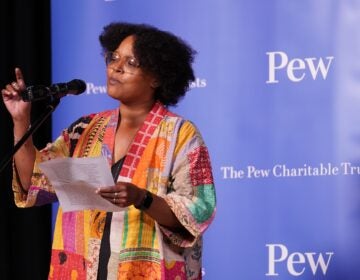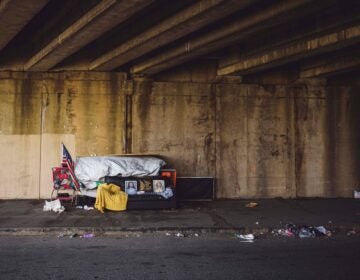Historic cemetery boasts big names in East Falls
Philadelphia’s underground museum is home to the city’s most prominent heroes, artists and architects.
Where can you meet financier Peter Widener, architect Frank Furness, naval war hero Isaac Hull, Gettysburg hero General George Gordon Meade, and sportscaster Harry Kalas in the space of a single afternoon stroll?
Two corrections have been made in this piece, including the first name of Ms. Yaster and the type of material used for the grave of Harry Kalas. This is the revised version.
The answer is Laurel Hill Cemetery, the final resting place for many of the city’s most illustrious citizens.
Set on a bluff overlooking the Schuylkill River, this pastoral National Historic Landmark boasts some of the finest funereal architecture in the country.
A forest of white marble columns topped with angels and crosses reach towards the heavens. Mausoleums, some the size of small houses, are built in a bewildering variety of styles: Neoclassical, Gothic revival, Egyptian, even Art Nouveau.
The cemetery’s 78 acres of winding roads, clipped lawns, and shade trees provide a refuge from the dense East Falls neighborhood just outside its gates.
See slideshow below
When it opened in 1836, Laurel Hill was on the cutting edge of cemetery design. It was the brainchild of editor John Jay Smith, who partnered with a group of prominent Philadelphians to create a so-called “garden cemetery.”
Their architect was John Notman, designer of the Athenaeum and several prominent Center City Episcopal churches.
Notman modeled his creation on Mount Auburn in Cambridge, Massachusetts and Père Lachaise in Paris. It would not be just another grim repository for bodies, but rather an aesthetic and emotional resource for the living.
The cemetery’s beauty was a response to the death obsessed culture in the Victorian era. Black mourning dresses and armbands were common sights on Philadelphia streets, and families often kept post-mortem photographs of loved ones on mantelpieces.
After passing through the Greek revival gatehouse, visitors paid respects to the deceased, walked the winding paths, admired the architecture, even picnicked amongst the headstones.
As an 1844 guidebook noted, Laurel Hill was a refuge where “the smitten heart might pour out its grief over the grave of a cherished one, secure from the idle gaze of heartless passengers, and where the mourner could rear a flower, consecrated to memory and hope.”
Cemetery founders had certain clientele in mind
In a morbid bit of marketing, they moved the bodies of prominent Philadelphians such as Declaration of Independence signer Thomas McKean to Laurel Hill as part of an effort to make it more desirable to prospective “residents.” The ploy worked. By the end of the nineteenth century, Laurel Hill had become a sort of eternal Rittenhouse Square.
It was also non-denominational – members of the Jewish Gratz family are interred alongside the Quaker Emlens and the Anglican Dobbinses. Among the most prominent monuments is the one for William Emlen Cresson, a painter who died at the age of 24 in 1868.
A life-size bronze of Cressson, sculpted by noted artist Joseph A. Bailley, is seated on a chair. Originally, Cresson held a brush and palette, but vandals stole these years ago, along with one of his boots.
Some opted for less elaborate displays – the grave of renowned architect Frank Furness is marked by a simple military headstone.
To Tom Keels, a volunteer tour guide and author of Philadelphia Graveyards and Cemeteries, the cemetery is a museum of a time when Philadelphia was the Workshop of the World.
For these men, mausoleums were mansions indeed. “Because so many of them started off poor and made it big,” he said, “they wanted to show everyone how important they were, and one way to do this was to build huge mausoleums.”
Burial ground serves as suburban sanctuary for the living
Few picnickers can be spotted on the grounds today, but Philadelphians still come here to take refuge from hectic urban life, and it is a fine place to watch regattas on the Schuylkill.
Laurel Hill also boasts many special events throughout the year. The October Halloween season is the busiest time of the year: there is the “Rest in Peace” 5K run through the grounds, the Gravediggers’ Ball benefit gala, and the Halloween Flashlight Tours.
Carol Yaster, the Board President of The Friends of Laurel Hill, says that despite all the events, the biggest challenge, still remains “letting people know we are here.”
Last year, Laurel Hill hired Alexander “Pete” Hoskins hired as its President and CEO. Hoskins is familiar with running a larger urban green space: he previously was head of the Philadelphia Zoo.
In addition to serving as interim Executive Director of the Friends of Laurel Hill, Hoskins also runs its suburban counterpart West Laurel Hill Cemetery, as well as Bringhurst and Turner Funeral Homes.
Hoskins hopes to greatly expand the number of trained guides (there are currently about a dozen), allowing for more “drop-in” tours in addition to the 40 or so scheduled tours per year. “We really want more people coming to visit the cemetery as a park,” he said.
Preserving the cemetery’s historic flavor
Maintaining the cemetery, which has 11,000 family plots, is no small undertaking. The cemetery now employs two paid office workers, as well as one superintendent and two full-time groundskeepers.
When asked about vandalism, Yaster replied that defacement has been less of a problem than the groundhog population, whose burrows have toppled some of the tombstones.
Help is on the way, however: Laurel Hill received a $100,000 challenge grant from philanthropist Dorrance Hamilton to restore the original landscape and plantings. Yaster says that this is no easy task, as graves now occupy the areas where trees once stood a century ago.
Planting will begin next spring, and Hoskins estimates that the restoration will cost about $5 million. One way to raise funds is to significantly increase the number of dues paying members of the Friends of Laurel Hill, which according to Hoskins stands at about 250.
For Keels and guides like him, the cemetery is more than just a quaint Victorian relic. “As babyboomers, we never thought we were going to die,” he said. “Now we are getting older and some of us are dying, or at least thinking about death. It’s a good idea to look at the past and see how they dealt with death in the 19th century and look at the emotions displayed in the monuments.”
But perhaps the most striking reminder of Laurel Hill’s relevance today is the final resting place of Phillies announcer Harry Kalas. The grave is marked by a gray Barre granite microphone, with the initials HK carved into its base. A set of chairs from Veterans Stadium flank the grave, allowing visitors to pay their respects the way Kalas would have liked best.
View photos on Flickr with captions.
WHYY is your source for fact-based, in-depth journalism and information. As a nonprofit organization, we rely on financial support from readers like you. Please give today.




